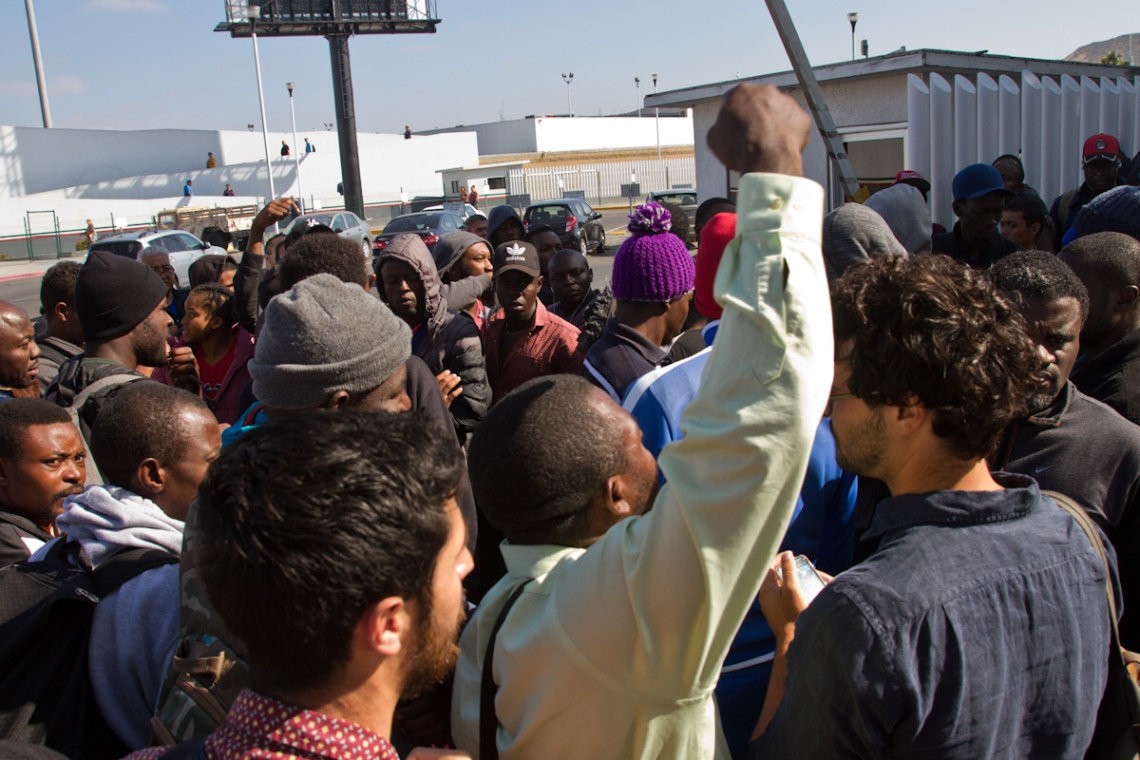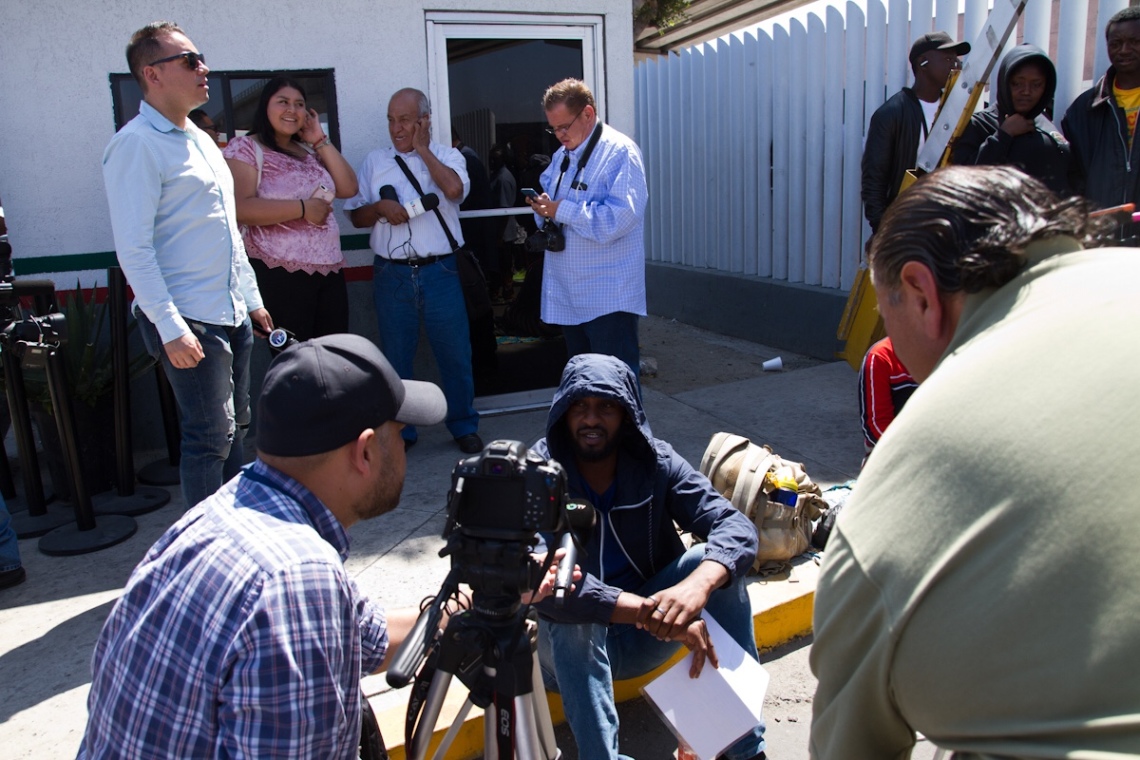Filed under: Action, Immigration, Northern Mexico, The State

Report from Commotion.World about recent actions at the border in Tijuana by migrants against conditions and corruption of officials. All photos by A. López Uribe.
On July 9, 2019, approximately 100 Cameroonians and Eriteans blocked the path of the Mexican vans that transport migrants to the U.S. The migrants protested Mexican officials taking bribes, not calling list numbers, and skipping over the Africans on the list.

African migrants, many fleeing political persecution, have been stuck in Tijuana for months.

Early every morning, migrants from all over the world gather at the El Chaparral port-of-entry to put their names on a wait list, get a number, and hear the numbers called for that day. This is how the process for seeking asylum in the U.S. begins. Your name on a list in a paper notebook kept at the El Chaparral port of entry. The list saves a spot for the few border-crossing slots that CBP makes available each day. When the Mexican government, Grupos Beta, calls your number you have the chance to cross and present yourself for asylum in the U.S. The list is a response to the U.S. police called metering, which managed the flow of migrants in Tijuana, Ciudad Juárez, and Ciudad Acuña, roughly since December 2017.

The CBP “metering” policy and the list came into effect when thousands of Haitian refugees fleeing destitution after Hurricane Matthew arrived at the southern border. The U.S. declined to allow the black migrants entry, instead requiring them either to wait for an asylum appointment with the CBP or try to cross the border on their own.

Consistent with the new “Third Country” rule, the U.S. has slowed down its acceptance of asylum-seekers at the Border this July. For the past four days, the Grupos Beta has called no numbers. All migrants continue to wait. The list continues to grow.
The number of names on the list has now reached more than 9,150 people, its highest number ever. The number of people taken by CBP for processing per day in January averaged about 42, that dropped to about 24 people per day in June.
From Tuesday July 1st to Sunday July 7th, Grupos Beta called no numbers in Tijuana. On Monday, July 8, they called the same number as July 1, which had been a large group divided into two and they were allowed to cross.
On Tuesday, July 9th, the Cameroonians and Eriteans blocked the street outside of the El Chaparral port-of-entry. They demanded fair treatment on the list. No numbers were called.
When the media responded to cover the blockade on Wednesday, the Grupos Beta resumed calling numbers but only one, so again ten people.
On Thursday, the Grupos Beta called three numbers, and then on Friday, Saturday and Saturday called no numbers.
During the protest, some migrants, mostly from Central America, called for the Africans to clear the street. The Central Americans believed that the protest was causing Grupos Beta to stop calling numbers and allowing people to cross. However, there is not way for the migrants to require the Grupos Beta to call numbers and the CBP to allow migrants to cross.

While they wait, many migrants sleep on the street near the U.S. border or group together to rent expensive apartments. Migrants from African countries have difficulty tapping into many of the resources available to Central American and Mexican migrants due to language and other cultural barriers. For example, instead of staying at shelters for migrants in Tijuana, Eritreans often pool their money to live in hotels, often in dangerous parts of the city, where they stay several people to a room. Though many Cameroonians in Tijuana are from a persecuted English-speaking minority, they have been able to access the Haitian community to an extent because they speak some French.

This year, here have been 1,044 detentions of African migrants in Mexico. Overall, their number has increased over the past five years, but migrants from Central African countries, like Eritrea, Cameroon, Angola and the Democratic Republic of Congo, have the highest proportions in 2019. Many have traveled through South America, Panama, Central America, and Mexico, only hit a dead end at the southern U.S. border. This influx poses a problem for the Mexican government, which can easily deport and turn away Central American migrants. Mexico has no effective way to return Africans.

After the blockade, eight African asylum-seekers met with Mexican officials. The protest ended after the government agreed to call the correct numbers and to allow the African migrants to double check the numbers.

There is no way to ensure that the Mexican government will abide by this agreement, just like there is no way to ensure that the U.S. will accept asylum-seekers.
Like the hunger strikes in November, the Africans’ protest has pushed back against this immigration system, which is not designed to help them find refuge, but instead designed to force them away.

Below is the report on the protest from KPBS, a local San Diego public radio:
The complaints of the Cameroonians stem from the Mexican authorities refusal to accept migrants from Africa for transport to the U.S. side of the border, where they can officially declare asylum. The Africans claim that days have gone by without Mexican officials calling any numbers from an unofficial “waiting list,” and yet Central American asylum seekers have been granted entry to the U.S. on those days.
“It’s corruption plain and simple,” said an asylum-seeker named Beatriz, who asked that her last name not be published. She said Central Americans have been paying bribes to the immigration officers. Beatriz has been waiting two months to cross into the United States and saw her number recently skipped over. “I can’t wait another two months.”
Asylum-seekers from Cameroon are, for the most part, members of the English-speaking minority in the country, and they have faced intense persecution since 2016. Many have traveled through South America, the jungles of Panama and Central America, only to run out of time and money south of the U.S. border.
“We’ve been suffering for two months. We have nothing to eat. We’re sick. Everything is finished,” said Stanley, an asylum seeker.
He also asked that his last name be withheld.
Stanley was part of a group of eight African asylum-seekers that were asked to meet with Mexican officials in the hopes of ending the protest, which had drawn the attention of the newly-formed Mexican National Guard.
After an hour-long meeting, the asylum-seekers and Mexican officials emerged with a “deal” that the African asylum-seekers would be able to verify the unofficial list each morning, to make sure the correct numbers were being called. The group dispersed and let the immigration vans proceed, but not without a promise by many to hold the Mexicans to their word in the final stage of what has been a very long journey for them.
Over a hundred asylum-seekers from Cameroon blocked the path of Mexican immigration vans Tuesday morning in Tijuana, in protest of what they believe to be corruption by Mexican immigration officials.





